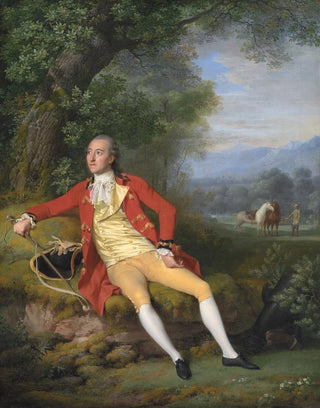Art print | Jean Armand Tronchin Ambassador to the French and English courts Switzerland - Jens Juel


View from behind

Frame (optional)
In the world of art, some works transcend the mere frame to become witnesses of an era, visual stories imbued with history and culture. The art print of Jean Armand Tronchin, Ambassador to the French and English courts, Switzerland - Jens Juel, fits into this tradition, evoking not only the charismatic personality of its subject but also the political and diplomatic context of the 18th century. Jean Armand Tronchin, an iconic figure in Swiss diplomacy, is depicted here with such finesse that every detail of his portrait seems to whisper the secrets of his time. The light, colors, and expressions are all keys that open the doors to a rich and complex past.
Style and uniqueness of the work
Jens Juel's work stands out for its striking realism and its ability to capture the very essence of its subjects. In this portrait, Tronchin is depicted with particular attention to his features and attire, which reflect not only his status but also the elegance of the fashion of his time. The subtle nuances of the palette, ranging from warm tones to delicate shadows, create an atmosphere that is both intimate and solemn. Juel, a true master of the art print, manages to establish a dialogue between the viewer and the subject, making the work lively and engaging. Every brushstroke, every detail of the composition, contributes to making this portrait a remarkable example of 18th-century art, where the psychology of the characters is highlighted with unprecedented depth.
The artist and his influence
Jens Juel, born in Denmark, established himself as one of the most influential portraitists of his time. His career, marked by prestigious commissions and international recognition, testifies to his exceptional talent and keen sense of observation. As a member of an artistic elite, Juel navigated between the various influences of his era, integrating elements of baroque while foreshadowing the beginnings of neoclassicism. His approach to the portrait, which combines realism and idealization, has inspired many contemporary and later artists. The representation of Tronchin continues

Matte finish

View from behind

Frame (optional)
In the world of art, some works transcend the mere frame to become witnesses of an era, visual stories imbued with history and culture. The art print of Jean Armand Tronchin, Ambassador to the French and English courts, Switzerland - Jens Juel, fits into this tradition, evoking not only the charismatic personality of its subject but also the political and diplomatic context of the 18th century. Jean Armand Tronchin, an iconic figure in Swiss diplomacy, is depicted here with such finesse that every detail of his portrait seems to whisper the secrets of his time. The light, colors, and expressions are all keys that open the doors to a rich and complex past.
Style and uniqueness of the work
Jens Juel's work stands out for its striking realism and its ability to capture the very essence of its subjects. In this portrait, Tronchin is depicted with particular attention to his features and attire, which reflect not only his status but also the elegance of the fashion of his time. The subtle nuances of the palette, ranging from warm tones to delicate shadows, create an atmosphere that is both intimate and solemn. Juel, a true master of the art print, manages to establish a dialogue between the viewer and the subject, making the work lively and engaging. Every brushstroke, every detail of the composition, contributes to making this portrait a remarkable example of 18th-century art, where the psychology of the characters is highlighted with unprecedented depth.
The artist and his influence
Jens Juel, born in Denmark, established himself as one of the most influential portraitists of his time. His career, marked by prestigious commissions and international recognition, testifies to his exceptional talent and keen sense of observation. As a member of an artistic elite, Juel navigated between the various influences of his era, integrating elements of baroque while foreshadowing the beginnings of neoclassicism. His approach to the portrait, which combines realism and idealization, has inspired many contemporary and later artists. The representation of Tronchin continues






